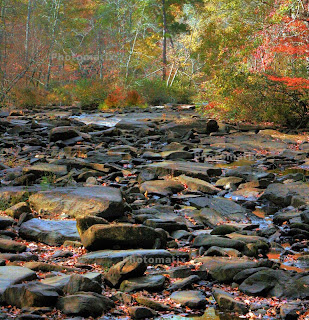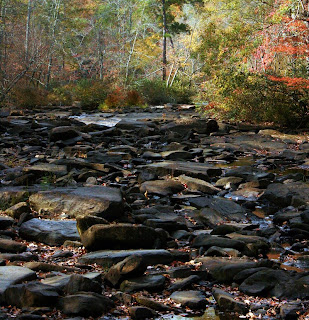

I am getting my feet wet with High Dynamic Range Imaging or HDRI or HDR. For the most part I see these images posted on the internet -- Flickr and the like -- and think...why? Why would someone do that to a perfectly good photo? Why cartoon or comic-book it up like they do?
Well -- I have seen some lately that don't come close to looking cartoonish (not that there is anything wrong with a cartoon -- but you know what I mean). Some I have seen -- usually the more architectural -- look pretty darn good. Still crossing over the threshold of a photo to blend photography and computer graphics -- but looking great.
These make me curious...
I kind of like them -- and that means I want to do one. So far all I have done is download a trial version of some software and play with a couple old photos I had. The software I chose is Photomatix from HDR Soft. You can download it -- the full version -- play with it and if you like it buy a code that will remove a watermark from your finished photos. I say I like this -- I don't know if I like it enough yet to buy the software. My feeling has always been -- I like to take a nice photo with the camera -- or I woud rather spend time with my camera than I would with the computer. Having the laptop has made this a little easier though. Now my 'darkroom' work is done in the evenings, after dinner, sitting with my feet up and I am on the couch. You have to admit there is not much worth watching on TV anyway -- so I might as well edit photos.
When you create an HDR photo you essentially have taken three photos of the same scene; one overexposed, one underexposed and one spot on. Since I am playing with old photos -- I only have the one version -- spot on. So I went into Elements to create the others. I opened my photo (jpg) in Camera RAW and used the exposure slider to create one photo +2 exposure value and another photo -2 exposure value. I saved each and of course the original. Then it was time to move on to the stand alone program of Photomatix and let it do its thing.
From there I followed directions and created a couple photos I thought looked OK. This is still very new to me and I don't know how much attention I will give it. I know I need to find some excellent architecture and give that a go. I have some old photos that would work -- but I really want to do it completely correct -- taking the three shots of the same scene and then merging those. I have never really used that auto exposure bracketing feature on the camera -- now it will get a work out.
The photos on the blog today are the regular and the HDR version of my 'Drought at Line Creek.' The lighter one is the HDR. If you look closely, you will see the Photomatix watermarks in the photo.
Also -- funny thing -- after I downloaded the program yesterday and started to play I checked out a friend's blog. Andy is a photographer I have known for a while. Guess what his blog post was about yesterday....HDR! Great minds think alike Andy! For more info on HDR -- check out Andy's blog here: Light Centric Photography.
Another thing I did yesterday was download the 7 Photography Questions podcast on HDR. Now I need to carve out a few minutes to listen to that.


1 comment:
Or maybe, mediocre minds just follow your lead, Donna? Ha Ha.
I think, like many "new" things out there, there are some serious misconceptions about High Dynamic Range Imaging (HDRI). I have been reading about it an watching is for a number of years, now. But until maybe the last 3 years, it has not been available as a software tool to us mere mortals at a cost which is affordable and an interface which doesn't require a PHD in computer programming (kidding--probably unfair to the programmers out there-but tongue in cheek). FDR Tools and Photomatix have changed that. I, too, eventually settled on Photomatix, as my article indicates, but I tried to give FDR tools a hard run.
"Image blending" is not really new at all. Making "contrast masks" in the darkroom was a pretty common practice. We have been working with layers and blending modes in Photoshop since its early inception. The problem, for most of us, is that it was "messy." Took lots of time, skill and computing power, and most of us want to spend our time behind the lens, not behind the monitor. What these new tools do is "automate" the blending process. For most of us "bread and butter" thinking photographers, what we are really looking for, in my opinion, is a "photorealistic" depiction of something our eyes can see, but a camera sensor -- or film, cannot.
I couldn't agree more about the "cartooning" side of it. Photomatix does basic blending (better than Photoshop does, in my view) better than I can do. It also give the knowledgeable user great latitude to do sophisticated "tone mapping" which is where I think users get into some of the more "surrealistic" (my eyes tell me its not realistic and so neither is the photo). I don't condemn that by any means. Its what art is all about. But I agree that I don't care for it myself.
One comment. Most commentators will tell you that taking a single RAW capture and trying to use it in Photomatix or FDR Tools to make a HDR file is not really useful. For the most part, you can "tease" the same things out of the RAW image in a good RAW editing software (Like Adobe Lightroom or even Adobe Camera RAW). Photomatix does have the capability of working with a single RAW image, too, but I doubt it is as robust as the RAW converters. Most commentators will tell you you should take at least 3 separate images, at least 2 full stops apart, to take full advantage of the power of Photomatix.
Post a Comment